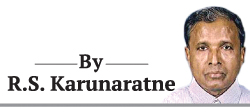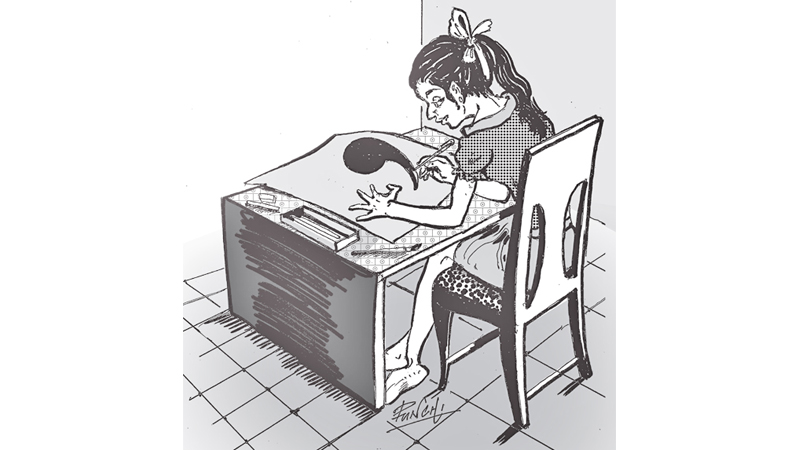 The apostrophe is the sign (’) used in writing to show that certain numbers or letters have been left out as in ‘don’t’ (do not) and ’86 (1986). It is also the same sign used before the letter ‘s’ to show that something belongs to someone or something, or is connected with them as in ‘John’s book’ or ‘Nixon’s last year as President.’
The apostrophe is the sign (’) used in writing to show that certain numbers or letters have been left out as in ‘don’t’ (do not) and ’86 (1986). It is also the same sign used before the letter ‘s’ to show that something belongs to someone or something, or is connected with them as in ‘John’s book’ or ‘Nixon’s last year as President.’
The apostrophe was first introduced way back in the 17th century. Old English was inflected and it had a possessive case. As there was no apostrophe in Old English, people wrote ‘kinges castle’ to show that the king owned the castle. The word ‘kinges’ was pronounced as two syllables. By a process of elision, in which one spoken syllable slides into another, the disyllabic ‘kinges’ became the monosyllabic ‘kings’.
Grammarians of the 17th century decided that the elided syllable should be indicated and introduced the apostrophe to show that something belonged to someone. Thereafter, people started writing ‘king’s castle’ or ‘bird’s feathers.’
In modern English, there are three uses of the apostrophe. In the first place, an apostrophe is used to indicate the omission of one or more letters of a word: 7 o’clock, can’t, isn’t and didn’t. ‘Could not’ is contracted as ‘Couldn’t’ omitting the second ‘O’. If there are only two words, the second word is normally contracted: ‘Shall not’ is contracted as ‘Shan’t’. For the plural of words which are not nouns or pronouns, we add ’S to the singular: If’s, and’s, but’s, will’s and shall’s.
An apostrophe is used for the plural of letters of the alphabet: Mind your p’s and q’s. How many l’s are there in the word ‘travelling?’ An apostrophe is also used for the plural of numbers when they are written as figures: Your 8’s are like 3’s. He was born in the 1990’s. However, the modern tendency is to omit the apostrophe. So we write: He was born in the 1990s.
An apostrophe is used to indicate the possessive or genitive case of a noun: That’s your umbrella. The apostrophe is used before ‘S’ for the genitive singular: My sister’s handbag. We use the apostrophe after ‘S’ for the genitive plural: My daughter attends a girls’ school. For nouns which do not make their plural in ‘S’ we add ’S to the singular: This is child’s play. She bought a woman’s hat. To indicate possession, we add ‘S to the plural: She reads children’s literature. Where do they sell women’s hats?
Possession
For personal names ending in ‘S’ we add an ’S to indicate possession: This is Jones’s house. Have you visited King Charles’s Palace? If an extra syllable is not pronounced in a name, place the apostrophe after the name: I spent a week at Humphrey’s flat. For nouns that sound like the plural of a common noun, do not add an extra syllable to indicate possession: Masters’, Stones’, Fields’, Knights’ or Vickers’.
When two names are taken together as a joint possessive, the possessive ending is added only to the last: Gilbert and Sullivan’s operas. We use ’s or s’ in phrases such as: It’s only a day’s journey. He received two weeks’ wages. You have to give three months’ notice.
There is no apostrophe in the possessive adjective: The dog wags its tail. It’s is a short form for ‘it is’ or ‘it has.’ Similarly, there is no apostrophe in the possessive pronouns: Hers, his, ours, yours or theirs. The indefinite pronoun ‘one’ has the genitive one’s, but there is no apostrophe in ‘oneself.’ Language learners may find it difficult to understand how to use the apostrophe correctly. They have to learn the rules and the exceptions. Thanks to competent teachers, many generations of students have learnt how to use the apostrophe correctly. However, difficulties remain in using or omitting the apostrophe.
Some language experts like Susan Butler, editor of the Macquarie Dictionary, Australia’s national dictionary, and a regular commentator on language use and abuse on radio, television and the internet says, “It’s time to punch out this confounded little punctuation mark.” She is referring the apostrophe.
The foregoing paragraphs show the importance of the apostrophe in written English. Those who find it difficult to use the apostrophe in writing will support Susan Butler’s views. However, she has not suggested any alternative to indicate the omission of letters or to show possession.
Misplaced apostrophe
Even in Britain, the misplaced apostrophe has been labelled the ‘greengrocer’s apostrophe’ from its frequent appearance on fruit shop signs. Placing the apostrophe in place names poses some difficulties.
A council in Devon has banned the use of the apostrophe from all road signs.
It has drawn protests from defenders of English punctuation. The United States has advocated abandoning the apostrophe in place names since the 1890s. Similarly, The Australian geographical name boards followed the US precedent in 1966. So, the Australian suburb King’s Cross is now known as Kings Cross without the apostrophe.
Those who protest against the use of the apostrophe argue that they do not need punctuation marks for street signs. However, their claim that the apostrophe should be expunged from our writing has to be viewed with caution. If the apostrophe is removed from books, it will lead to some confusion. Without the apostrophe, how can we indicate possession or omission of letters from a word?
The debate whether we should abandon the apostrophe may not be immediately relevant to Sri Lanka. However, language teachers in the United States and Australia consider it as an important issue. Abandoning a long-standing punctuation mark is easy, but what are we going to do with the words that carry apostrophes?
Therefore, we should not be in a hurry to do away with the apostrophe right now. Let us find an alternative before dumping the apostrophe because it has existed for four centuries and our teachers have taught us the intricacies of using it correctly.
Figure of speech
By the way, apostrophe is a figure of speech in which a speaker directly addresses someone or something that is not present or cannot respond in reality. The entity being addressed can be an absent, dead or imaginary person, but it can be an inanimate object like stars or the ocean. It can also be an abstract idea like love or fate. Sometimes, the object addressed may be an imaginary being such as Muse or god. Therefore, apostrophe, the figure of speech, should not be confused with apostrophe, the punctuation mark.
The word ‘apostrophe’ comes from ancient Greek. It literally means ‘turning away.’ To perform apostrophe on stage, an actor turns away from the scene to address an absent entity.
One of the earliest and most famous examples of apostrophe in literature comes from Homer who begins both ‘The Iliad’ and ‘The Odyssey’ with an invocation to the Muse, the Goddess of the Arts. William Shakespeare too used apostrophe to address abstract ideas or inanimate objects. In ‘Macbeth’, Macbeth sees an apparition of a dagger and addresses it:
“Is this the dagger I see before me,
The handle towards my hand? Come let me clutch thee
I have thee not, and yet I see thee still
Art thou not, fatal vision, sensible
To feeling as to sight?








